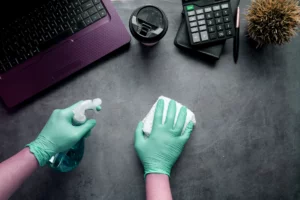
Disinfectants became very popular in the past few years. However, using them is a bit more complicated than simply spraying them on a surface and wiping them away. There are certain things that should be done but are usually overlooked by people. Keep reading to find out what the most common mistakes are and make sure to avoid them next time you are attempting to sanitise a surface or an item.
There are many things to understand about household disinfectant sprays, such as the distinction between cleaning, sanitising, and disinfecting. It’s simple to believe that spraying a surface instantaneously kills germs. However, disinfection is more complicated than merely spraying a surface.
Not reading and following label instructions
You might want to start cleaning and disinfecting your home right away, but it’s sometimes better to take your time. The most mistake is failing to read and follow the instructions on the label. Because disinfection items are in high demand, you might bring home something you’re not familiar with. Don’t expect it to work the same way as the one you are used to but couldn’t find. To achieve the intended effect, carefully read and follow the instructions.
You don’t let the product sit long enough
If you think that disinfectant spray works immediately after you spray it on the surface, you are wrong. This is a very common mistake and it will in fact prevent the product from working efficiently. You need to let it sit for long enough so that it has time to kill germs and bacteria. If you are not certain, check the label of the product to see what the recommended time is. That way you will ensure that your product has the chance to be most effective. Some disinfectants may require up to 10-15 minutes.
Not spraying enough product
Along with the step above where you let the disinfectant sit for a certain period of time, you need to ensure that it stays wet in the meantime. To do that, you should spray enough disinfectant on the surface. Such information should be mentioned on the label as well.
Thinking sprays work in the long term
Disinfectant sprays may accomplish a lot of things…except clean the air. Another crucial point to remember is that they do not sanitise the air, only the surface they are applied on. People must use them on a regular basis (for example, during the pandemic, government buildings are disinfected on a schedule—every two to four hours depending on the chemicals used) to guarantee that the surface remains disinfected. In general, the distance from which you spray the disinfectant is unimportant.
Not cleaning the surface before disinfecting it
Yes, before disinfecting, the surface must be thoroughly cleaned. Keep in mind, however, that the phrases sanitising and disinfection are not synonymous. Sanitizers reduce the amount of bacteria in the environment, whereas disinfectants eliminate all germs. In this sense, consumers should purchase disinfectants rather than sanitizers.
How to properly clean and disinfect surfaces?
To clean, sanitise, and disinfect a surface, you must first understand your supplies. There are numerous products that clean and disinfect at the same time, but you should use a solution designed specifically for the surface you’re cleaning (for example, bathroom spray on bathroom counters) and then follow up with a dedicated disinfectant on the cleansed surface. You may want to hire a professional to clean your home from time to time. Cleaning is also done in a certain way. It’s not as haphazard as you may think. Cleaning should be done clockwise and from top to bottom, alternating between cleaning and disinfecting. For example, clean your bathroom sink and counter, then disinfect them before cleaning your shower. When the shower is clean, spray it with disinfectant before returning to dry off the sink, counter, and so on.
What type of disinfectant should you choose
It is best to use a product that you are familiar with or have already used. However, we suggest you avoid using solutions that contain bleach or ammonia, as they may be dangerous for your health. Nowadays, there are many non-toxic, green cleaning solutions that will be efficient in killing germs and bacteria but also safe for your health.
Check the expiration date
As most cleaning products, disinfectants do have an expiration date. The ones that contain alcohol may go off faster than others. It is important to always check the packaging for the date and to not rely on expired products. No matter how strong the product is, it cannot be trusted once it has gone off. Always place the products that are about to expire sooner in the front of your cabinet and always check them in the store before buying. Same goes for all your cleaning products.
